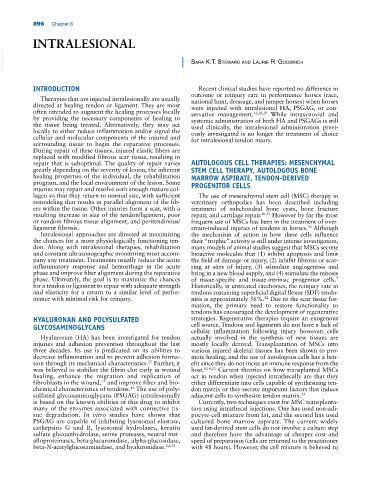Page 930 - Adams and Stashak's Lameness in Horses, 7th Edition
P. 930
896 Chapter 8
INTRALESIONAL
VetBooks.ir Sara K.T. STewarD anD Laurie r. GooDrich
INTRODUCTION Recent clinical studies have reported no difference in
outcome or reinjury rate in performance horses (race,
Therapies that are injected intralesionally are usually national hunt, dressage, and jumper horses) when horses
directed at healing tendon or ligament. They are most were injected with intralesional HA, PSGAG, or con-
often intended to augment the healing processes locally servative management. 12,28,29 While intrasynovial and
by providing the necessary components of healing to systemic administration of both HA and PSGAGs is still
the tissue being treated. Alternatively, they may act used clinically, the intralesional administration previ-
locally to either reduce inflammation and/or signal the ously investigated is no longer the treatment of choice
cellular and molecular components of the injured and for intralesional tendon injury.
surrounding tissue to begin the reparative processes.
During repair of these tissues, injured elastic fibers are
replaced with modified fibrous scar tissue, resulting in
repair that is suboptimal. The quality of repair varies AUTOLOGOUS CELL THERAPIES: MESENCHYMAL
greatly depending on the severity of lesion, the inherent STEM CELL THERAPY, AUTOLOGOUS BONE
healing properties of the individual, the rehabilitation MARROW ASPIRATE, TENDON‐DERIVED
program, and the local environment of the lesion. Some PROGENITOR CELLS
injuries may repair and resolve with enough mature col-
lagen so that they return to normal size, with sufficient The use of mesenchymal stem cell (MSC) therapy in
remodeling that results in parallel alignment of the fib- veterinary orthopedics has been described including
ers within the tissue. Other injuries form a scar, with a treatment of subchondral bone cysts, bone fracture
resulting increase in size of the tendon/ligament, poor repair, and cartilage repair. 26,32 However by far the most
or random fibrous tissue alignment, and peritendinous/ frequent use of MSCs has been in the treatment of over-
ligament fibrosis. strain‐induced injuries of tendons in horses. Although
35
Intralesional approaches are directed at maximizing the mechanism of action in how these cells influence
the chances for a more physiologically functioning ten- their “trophic” activity is still under intense investigation,
don. Along with intralesional therapies, rehabilitation many models of animal studies suggest that MSCs secrete
and constant ultrasonographic monitoring must accom- bioactive molecules that (1) inhibit apoptosis and limit
pany any treatment. Treatments usually reduce the acute the field of damage or injury, (2) inhibit fibrosis or scar-
inflammatory response and hemorrhage in the acute ring at sites of injury, (3) stimulate angiogenesis and
phase and improve fiber alignment during the reparative bring in a new blood supply, and (4) stimulate the mitosis
phase. Ultimately, the goal is to maximize the chances of tissue‐specific and tissue‐intrinsic progenitor cells.
7
for a tendon or ligament to repair with adequate strength Historically, in untreated racehorses, the reinjury rate in
and elasticity for a return to a similar level of perfor- tendons sustaining superficial digital flexor (SDF) tendo-
mance with minimal risk for reinjury. nitis is approximately 56%. Due to the scar tissue for-
12
mation, the primary need to restore functionality to
tendons has encouraged the development of regenerative
HYALURONAN AND POLYSULFATED strategies. Regenerative therapies require an exogenous
GLYCOSAMINOGLYCANS cell source. Tendons and ligaments do not have a lack of
cellular inflammation following injury however; cells
Hyaluronan (HA) has been investigated for tendon actually involved in the synthesis of new tissues are
injuries and adhesion prevention throughout the last mostly locally derived. Transplantation of MSCs into
three decades. Its use is predicated on its abilities to various injured skeletal tissues has been shown to pro-
decrease inflammation and to prevent adhesion forma- mote healing, and the use of autologous cells has a ben-
27
tion through its mechanical characteristics. Further, it efit since they do not incite an immune response from the
was believed to stabilize the fibrin clot early in wound host. 8,14,22 Current theories on how transplanted MSCs
healing, enhance the migration and replication of act in tendon when injected intrathecally are that they
fibroblasts in the wound, and improve fiber and bio- either differentiate into cells capable of synthesizing ten-
15
46
chemical characteristics of tendons. The use of poly- don matrix or they secrete important factors that induce
sulfated glycosaminoglycans (PSGAG) intralesionally adjacent cells to synthesize tendon matrix. 35
is based on the known abilities of this drug to inhibit Currently, two techniques exist for MSC transplanta-
many of the enzymes associated with connective tis- tion using intrathecal injections. One has used non‐adi-
sue degradation. In vitro studies have shown that pocyte‐cell mixture from fat, and the second has used
PSGAG are capable of inhibiting lysosomal elastase, cultured bone marrow aspirate. The current widely
cathepsins G and B, lysosomal hydrolases, keratin used fat‐derived stem cells do not involve a culture step
sulfate glycoanhydrolase, serine proteases, neutral met- and therefore have the advantage of cheaper cost and
alloproteinases, beta‐ glucuronidase, alpha‐glucosidase, speed of preparation (cells are returned to the practitioner
beta‐N‐acetylglucosaminidase, and hyaluronidase. 2,6,31 with 48 hours). However, the cell mixture is believed to

